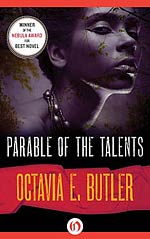
![]() Naomi_uk72
Naomi_uk72
5/29/2015
![]()
Where Parable of the Sower introduces us to protagonist Lauren Olamina and her journey towards the creation of her first Earthseed community, Parable of the Talents shows us the downfall and eventual rebirth of that community, albeit as a community that is more diffuse and distributed.
It begins five years after the settlement of Acorn, the Earthseed community founded at the end of the first book, and initially shows us the ways in which the community has grown and adapted to the ongoing social collapse that is taking place in the rest of the United States. For a short while life in the community seems good, though there is an undercurrent of possible danger presented in the form of Presidential hopeful Andrew Steele Jarrett, a Christian hardliner who believes that only a return to 'traditional Christian values' will help the country return to its former glory. Even despite Acorn's success, Lauren is also fighting against her own husband's desire to move them away from the community to somewhere 'safer', especially after she becomes pregnant; his fear of the future works directly in opposition to her inherent optimism, and the reader is given a deeper understanding of both sides of the argument as a result of their interaction.
Things begin to fall apart when Jarrett is elected as President, and shortly afterwards the community is attacked by a group of Christian America (CA) Crusaders, the members of the community enslaved. This is where the novel enters its darkest phase as we are given first hand accounts of the abuses meted out on Lauren's people. The children of the community, including Lauren's newborn baby, are taken away, and the men and women of the community are segregated and kept apart. Everything they have built for themselves is torn down and destroyed, and Acorn itself is transformed into a concentration camp, rapidly populated with new internees as the CA Crusaders seek to enslave and dehumanise those they see as a threat to their Christian traditions.
The third act of the novel begins with the prisoners at Acorn winning their freedom, though there is a sense of deus ex machina interjected at this point; the slavers themselves are rendered all but impotent when their living quarters are demolished as a result of a mudslide, allowing the prisoners to break free of their chains and escape. Lauren then sets out to locate and rescue as many of the lost children as possible, particularly her own lost daughter. Along the way we're given a broader picture of the world beyond the confines of Acorn, and it's suggested that those on the outside either don't care about the atrocities being committed by the Crusaders or simply aren't willing to believe that they'd be capable of such acts.
Lauren finally finds her daughter several years later, though the meeting between them is somewhat bittersweet. During her travels Lauren has managed to sow the seeds of a much larger Earthseed movement, while her daughter has been raised in a predominantly Christian manner, albeit while maintaining a degree of skepticism along the way. While there's no happy reunion between them, there is a reconciliation of sorts.
The narrative throughout the book alternates between the voice of Lauren herself, in the form of journal entries, and the voice of her daughter, Larkin, who we eventually learn has been separated from her mother for most of her life. By juxtaposing the two voices in this way we get a strong sense that while Larkin admires and respects the achievements of her mother, it's made clear that she doesn't necessarily agree with her mother's motives and beliefs.
In conclusion, if Parable of the Sower was a dark and disturbing read, this book is even more so. For that reason I'd consider it to outstanding, and definitely worth a read, though it should be noted that some of the themes the book explores may be triggering for some readers.